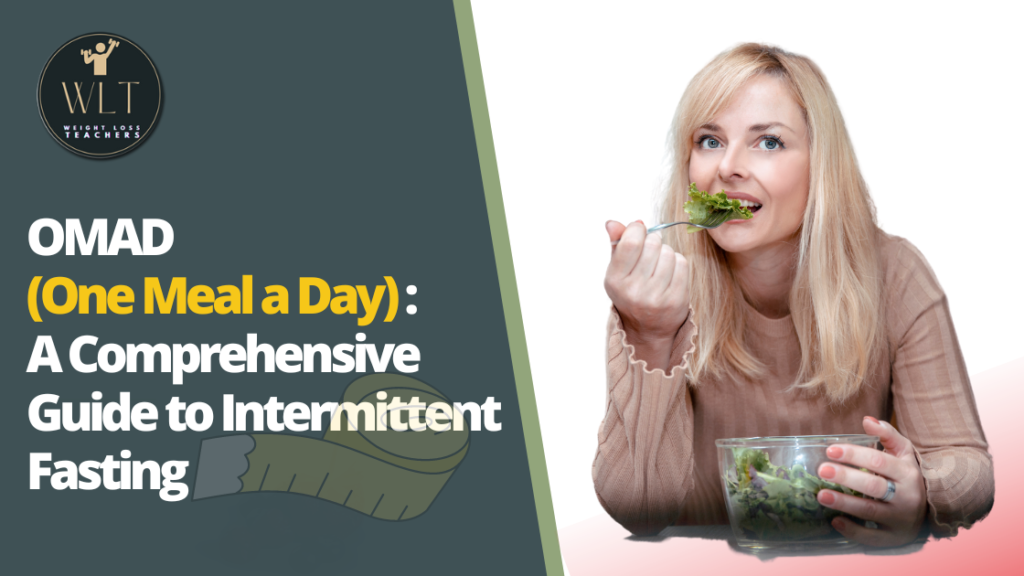
OMAD (One Meal a Day): A Comprehensive Guide to Intermittent Fasting

In recent years, the concept of intermittent fasting has gained significant popularity as a powerful tool for weight loss, improved health, and increased longevity.
Table of Contents
Introduction
One particular approach that has caught the attention of many is OMAD, or One Meal a Day. This eating pattern involves consuming your entire daily caloric intake within a single meal, while fasting for the remaining 23 hours. In this comprehensive guide, we will delve into the principles, benefits, potential risks, and practical tips associated with OMAD, shedding light on this intriguing fasting method.

Understanding OMAD

OMAD is an intermittent fasting approach that involves restricting your eating window to a single meal, typically lasting around one hour, and fasting for the remaining 23 hours of the day. During the fasting period, you can consume non-caloric beverages like water, black coffee, and herbal tea. The concept behind OMAD is to optimize your body’s ability to burn stored fat by extending the fasting period.
The Science behind OMAD

OMAD operates on the principle of intermittent fasting, which involves alternating periods of eating and fasting. By compressing your eating window to just one meal a day, you introduce an extended fasting period that can have various physiological effects on the body.
When you consume a meal, your body breaks down the food into glucose, which is used for energy or stored as glycogen in the liver and muscles. During a fasting state, when the body exhausts its glycogen stores, it enters a state of ketosis. Ketosis occurs when the liver begins converting stored fat into ketones, which are then utilized as an alternative fuel source for the body and brain.
The shift from relying on glucose to utilizing stored fat for energy is the underlying mechanism behind the weight loss benefits of OMAD. By extending the fasting period, you give your body more time to deplete its glycogen stores and tap into fat stores for fuel. This can result in increased fat burning and weight loss over time.
Additionally, OMAD can have an impact on hormone regulation, particularly insulin. Insulin is a hormone released by the pancreas in response to elevated blood glucose levels. Its primary role is to facilitate the uptake of glucose into cells for energy or storage. However, when insulin levels are chronically high due to frequent meals and snacking, the body can become less sensitive to its effects, leading to insulin resistance.
Fasting triggers a decrease in insulin levels, allowing stored fat to be released and burned for energy. By reducing the frequency of meals, OMAD helps regulate insulin production, preventing frequent insulin spikes and promoting more stable blood sugar levels. This can improve insulin sensitivity, which is crucial for managing blood sugar levels and reducing the risk of developing type 2 diabetes.
Moreover, fasting has been shown to increase the release of growth hormone, which plays a role in fat burning, muscle preservation, and overall body composition. Growth hormone stimulates the breakdown of stored fat and enhances protein synthesis, which helps maintain muscle mass even during periods of caloric restriction.
Additionally, during fasting, the body increases the production of norepinephrine, a hormone that stimulates the breakdown of fat cells. Higher levels of norepinephrine can increase metabolic rate and promote greater fat oxidation.
Furthermore, fasting has been associated with improvements in various health markers. Research suggests that it can reduce inflammation, improve blood lipid profiles by decreasing triglyceride levels and increasing HDL (good) cholesterol levels, and lower blood pressure. These effects can have a positive impact on cardiovascular health and reduce the risk of heart disease.
Benefits of OMAD

Weight Loss and Body Composition
OMAD can be an effective tool for weight loss due to its ability to create a calorie deficit. By consuming all your daily calories in one meal, you naturally limit your caloric intake. This restriction can help promote weight loss by ensuring that your body is in an energy deficit, meaning it is burning more calories than it is consuming. Additionally, the prolonged fasting period associated with OMAD can enhance fat oxidation. When the body exhausts its glycogen stores during fasting, it begins to rely on stored fat for energy, leading to greater fat loss.
In terms of body composition, OMAD has shown potential for preserving muscle mass. It is important to incorporate an adequate amount of protein in your single meal to support muscle maintenance and repair. By prioritizing lean protein sources such as chicken, fish, legumes, and tofu, you can help maintain muscle while losing fat, resulting in a healthier body composition.
Insulin Sensitivity and Blood Sugar Control
OMAD may have positive effects on insulin sensitivity, which is crucial for managing blood sugar levels and reducing the risk of developing type 2 diabetes. When you consume food, particularly carbohydrates, insulin is released to help transport glucose into cells for energy. However, frequent insulin spikes can lead to insulin resistance over time.
By limiting the frequency of meals, OMAD helps regulate insulin production, preventing frequent spikes and promoting more stable blood sugar levels. This can improve insulin sensitivity and reduce the risk of insulin resistance. It is important to focus on consuming whole, unprocessed carbohydrates, such as fruits, vegetables, and whole grains, during your meal to support stable blood sugar levels.
Enhanced Cognitive Function
Fasting has been linked to various benefits for brain health and cognitive function. OMAD, in particular, may enhance cognitive function by promoting the production of brain-derived neurotrophic factor (BDNF), a protein that supports the growth and maintenance of neurons. Increased levels of BDNF have been associated with improved learning, memory, and overall brain health.
In addition, OMAD can improve neuroplasticity, which refers to the brain’s ability to adapt and change. This can enhance cognitive flexibility, problem-solving skills, and creativity. Some studies have even suggested that intermittent fasting may have neuroprotective effects, potentially reducing the risk of neurodegenerative diseases such as Alzheimer’s and Parkinson’s.
Improved Heart Health
OMAD has the potential to improve several markers of cardiovascular health. Research suggests that intermittent fasting may help lower blood pressure, reduce triglyceride levels, and decrease inflammation, all of which contribute to better heart health. By promoting weight loss, reducing visceral fat, and improving insulin sensitivity, OMAD may help reduce the risk of heart disease.
Additionally, fasting triggers a process called autophagy, which helps remove damaged cells and proteins from the body. This cellular cleaning and repair mechanism may also benefit heart health by reducing oxidative stress and inflammation.
Increased Autophagy and Cellular Repair
During fasting, the body activates autophagy, a natural cellular process that involves breaking down old or damaged cells and proteins. This process helps eliminate dysfunctional components and promotes cellular rejuvenation. OMAD can further enhance autophagy due to the prolonged fasting period it entails.
By increasing autophagy, OMAD may have anti-aging effects and improve cellular health. It helps remove accumulated waste products and supports the regeneration of new, healthier cells. This process may play a role in reducing the risk of chronic diseases associated with aging, such as cancer, cardiovascular disease, and neurodegenerative disorders.
Simplicity and Convenience
One of the key advantages of OMAD is its simplicity and convenience. Traditional diets often involve multiple meals and snacks throughout the day, which can be time-consuming and require meticulous planning. With OMAD, you can focus on preparing and enjoying a single, satisfying meal.
This approach may simplify meal planning, grocery shopping, and food preparation. It can also provide a sense of structure and discipline in your eating habits. OMAD allows you to allocate your time and energy towards other activities, as you are not constantly thinking about or preparing food throughout the day.
In summary, OMAD (One Meal a Day) is an intermittent fasting approach that offers several potential benefits, including weight loss, improved insulin sensitivity, enhanced cognitive function, improved heart health, increased autophagy, and cellular repair. However, it is essential to consider potential risks, ensure nutritional adequacy, and listen to your body’s needs. OMAD may not be suitable for everyone, and individualized approaches should be taken into account. Consulting with a healthcare professional or registered dietitian is advisable to determine if OMAD is appropriate for you and to ensure its safe implementation.
Potential Risks and Precautions

Nutritional Deficiencies
Consuming all your daily calories in one meal can make it challenging to meet all your nutritional needs. It’s crucial to ensure that your meal is well-balanced and includes a variety of nutrient-dense foods to prevent potential deficiencies. Incorporate lean proteins, whole grains, fruits, vegetables, and healthy fats into your meal. Consulting with a healthcare professional or registered dietitian can help you develop a suitable meal plan and ensure adequate nutrient intake.
Disordered Eating Patterns
OMAD may not be suitable for individuals with a history of disordered eating or those prone to restrictive eating habits. The focus should be on adopting a healthy relationship with food and implementing OMAD in a sustainable and psychologically healthy manner. It’s essential to maintain a balanced approach to eating and prioritize overall well-being rather than solely focusing on weight loss or body composition.
If you have concerns about your eating habits or a history of disordered eating, it is highly recommended to seek guidance from a healthcare professional or therapist experienced in eating disorders.
Hunger and Discomfort
The extended fasting period of OMAD may lead to feelings of hunger and discomfort, especially during the initial adjustment phase. It’s important to listen to your body and ensure that you are adequately hydrated and nourished during your eating window. Experimenting with different meal compositions, including sufficient protein, fiber, and healthy fats, can help increase satiety and reduce hunger.
Additionally, incorporating strategies like mindful eating, staying busy, and distracting yourself during fasting periods can help manage hunger and discomfort. Over time, as your body adjusts to the eating pattern, these feelings may diminish.
Individual Suitability
OMAD may not be suitable for everyone. Factors such as age, medical conditions, medication use, and individual metabolic differences should be taken into consideration. Certain populations, such as pregnant or lactating women, individuals with diabetes or other chronic conditions, and those with specific nutrient requirements, may need to approach OMAD with caution or avoid it altogether.
If you have any underlying health concerns, it’s advisable to consult with a healthcare professional before starting OMAD or any fasting regimen. They can provide personalized guidance based on your specific circumstances.
Disclaimer: The information provided in this article is for educational purposes only and should not be considered as a substitute for medical advice. Consult a healthcare professional before implementing any home remedies or making significant changes to your lifestyle.
Implementing OMAD Safely and Effectively

Adjusting to OMAD
Transitioning to OMAD should be done gradually. Start by reducing your eating window over a period of time, such as gradually decreasing the number of meals or snacks you consume throughout the day. This allows your body to adapt to the fasting state more comfortably.
During the adjustment period, it’s important to listen to your body’s hunger and fullness cues. If you experience severe discomfort or significant changes in energy levels, it may be necessary to modify the approach or consult a healthcare professional.
Meal Composition and Nutritional Requirements
To ensure you meet your nutritional needs within a single meal, focus on including a balance of macronutrients (protein, carbohydrates, and healthy fats) as well as a variety of micronutrients (vitamins and minerals).
Include lean protein sources such as chicken, fish, tofu, or legumes to support muscle maintenance and repair. Incorporate whole grains, fruits, and vegetables to provide complex carbohydrates, fiber, and essential vitamins and minerals. Healthy fats from sources like nuts, seeds, avocado, and olive oil can provide satiety and support overall health.
Hydration and Fasting Aids
Staying adequately hydrated is crucial during fasting. Drink plenty of water throughout the day to maintain hydration levels. Herbal tea or other non-caloric beverages can also be consumed during the fasting period.
Some people find that incorporating electrolytes or a small amount of sea salt in their water can help with hydration and alleviate potential side effects of fasting. However, it’s important to avoid sugary drinks or beverages that contain calories, as they can break the fast and disrupt the benefits of OMAD.
Exercise and Physical Activity
Regular exercise can complement the effects of OMAD by promoting fat loss, maintaining muscle mass, and improving overall health. However, it’s important to listen to your body and adjust your exercise routine accordingly.
Avoid intense workouts during the fasting period, as you may experience decreased energy levels. Instead, focus on incorporating moderate-intensity activities such as brisk walking, yoga, or strength training. It’s essential to fuel your body appropriately after exercising to support recovery and meet your nutritional needs within your eating window.
Frequently Asked Questions (FAQs)
Q1. Is OMAD suitable for everyone?
A1. OMAD may not be suitable for everyone, especially those with specific health conditions or nutrient requirements. It’s important to consider individual circumstances and consult with a healthcare professional before starting OMAD.
Q2. Can I drink coffee or tea during the fasting period?
A2. Generally, non-caloric beverages like black coffee, unsweetened tea, or water are allowed during the fasting period as they do not significantly impact insulin levels. However, adding cream, sugar, or other caloric additives to your beverages breaks the fast.
Q3. How long does it take to adjust to OMAD?
A3. The adjustment period varies from person to person. It may take a few days to a few weeks for your body to adapt to the new eating pattern. Pay attention to your body’s signals and make adjustments as needed.
Q4. What should I eat during my meal?
A4. Focus on incorporating a variety of nutrient-dense foods, including lean proteins, whole grains, fruits, vegetables, and healthy fats. This will help ensure you meet your nutritional needs within a single meal.
Q5. Can I still achieve my nutritional requirements with OMAD?
A5. It is possible to meet your nutritional requirements with OMAD by focusing on nutrient-dense foods and ensuring a well-balanced meal. However, it’s important to consult with a healthcare professional or registered dietitian to tailor the approach to your specific needs and ensure nutritional adequacy.
Q6. How does OMAD stimulate autophagy and cellular repair?
A6. OMAD increases autophagy, a process that breaks down old or damaged cells and proteins, promoting cellular rejuvenation and potentially reducing the risk of age-related diseases.
Q7. Is OMAD a convenient eating pattern?
A7. Yes, OMAD is known for its simplicity and convenience, as it involves only one meal a day, reducing the need for frequent meal planning and preparation.
Q8. What are the potential risks of OMAD fasting?
A8. Potential risks include nutritional deficiencies, disordered eating patterns, hunger and discomfort during fasting, and the suitability of OMAD for specific individuals.
Q9. How can I implement OMAD safely and effectively?
A9. To implement OMAD safely, transition gradually, focus on meal composition, stay hydrated, adjust exercise routines, and consider individual factors such as age and health conditions.
Q10. Who should consult a healthcare professional before starting OMAD?
A10. Individuals with underlying health concerns, such as pregnant or lactating women, those with diabetes or specific nutrient requirements, or anyone unsure about OMAD’s suitability, should seek guidance from a healthcare professional before starting this fasting regimen.
Conclusion
Implementing OMAD (One Meal a Day) safely and effectively involves considering potential risks, ensuring nutritional adequacy, and adjusting to the eating pattern gradually. It may not be suitable for everyone, and individualized approaches should be taken into account. By consulting with a healthcare professional or registered dietitian, you can determine if OMAD is appropriate for you and receive personalized guidance for its implementation.






